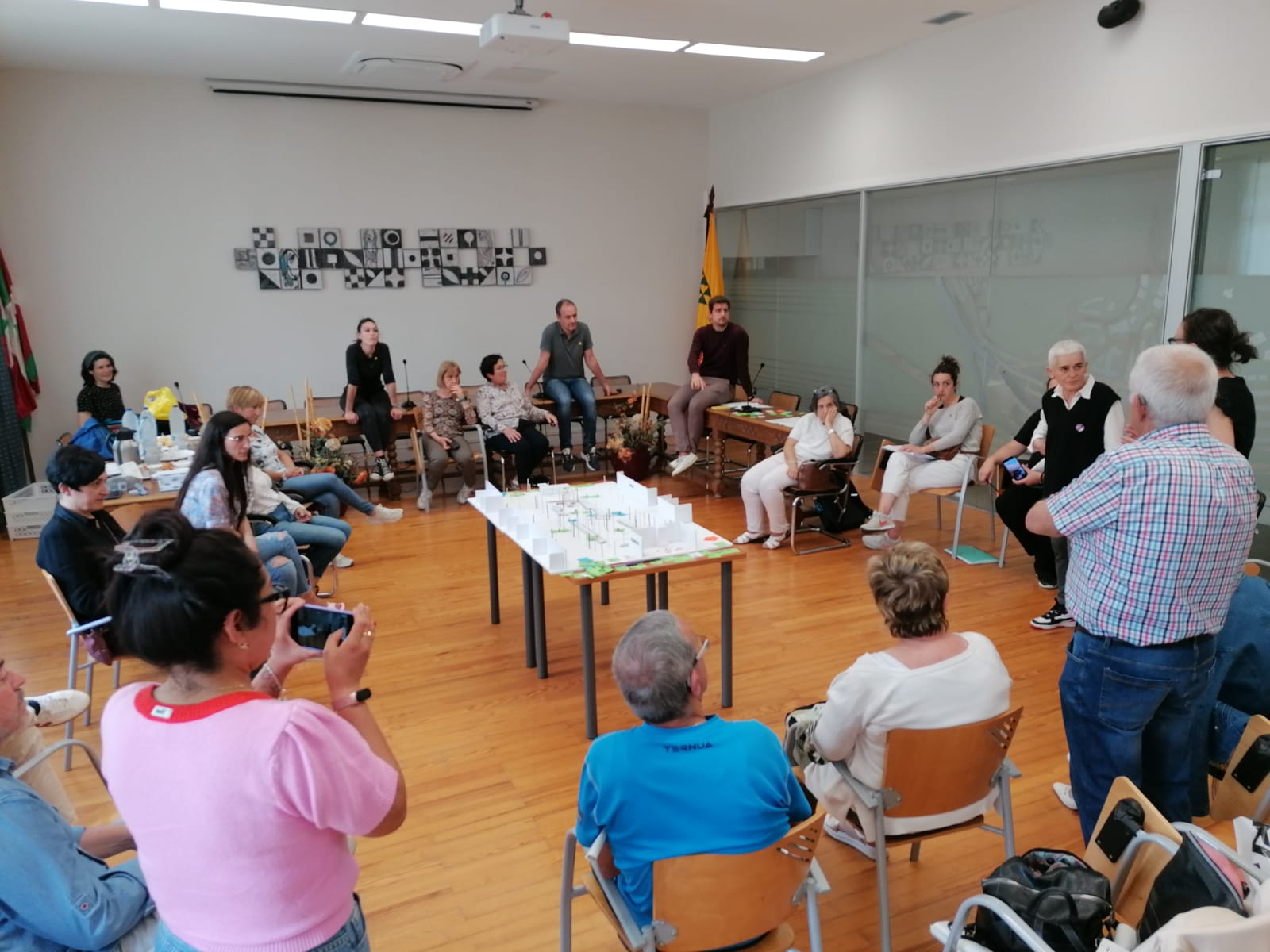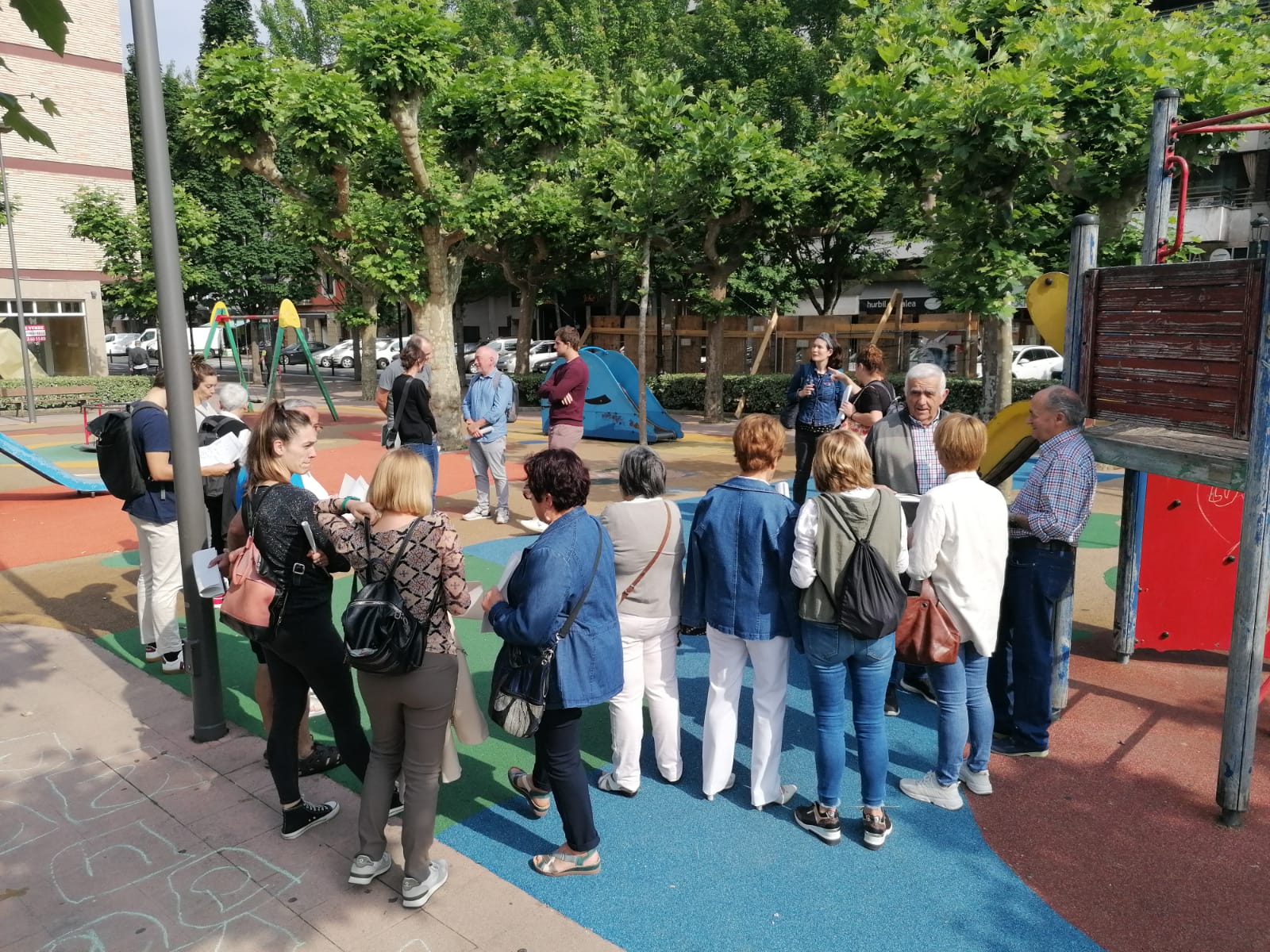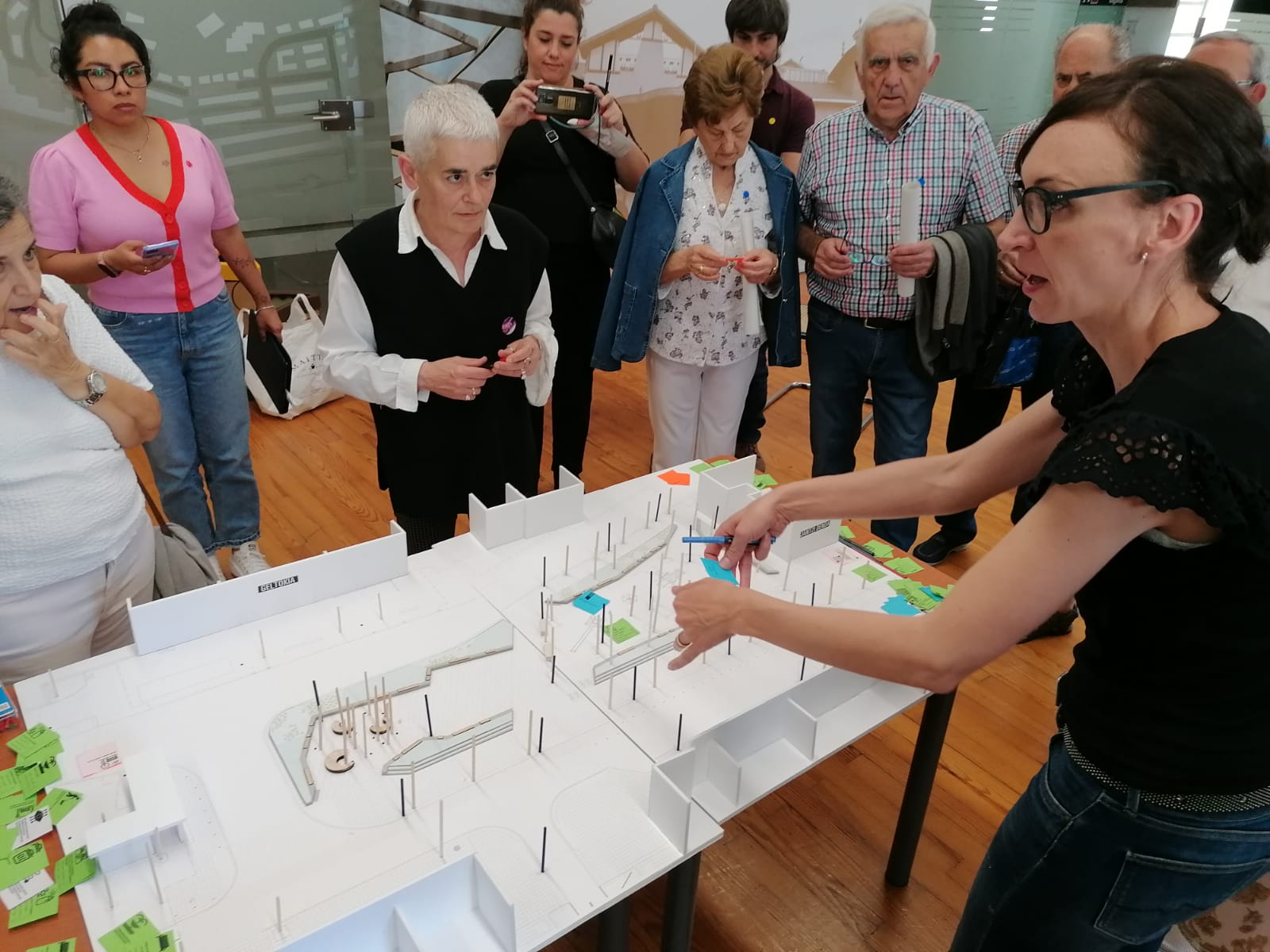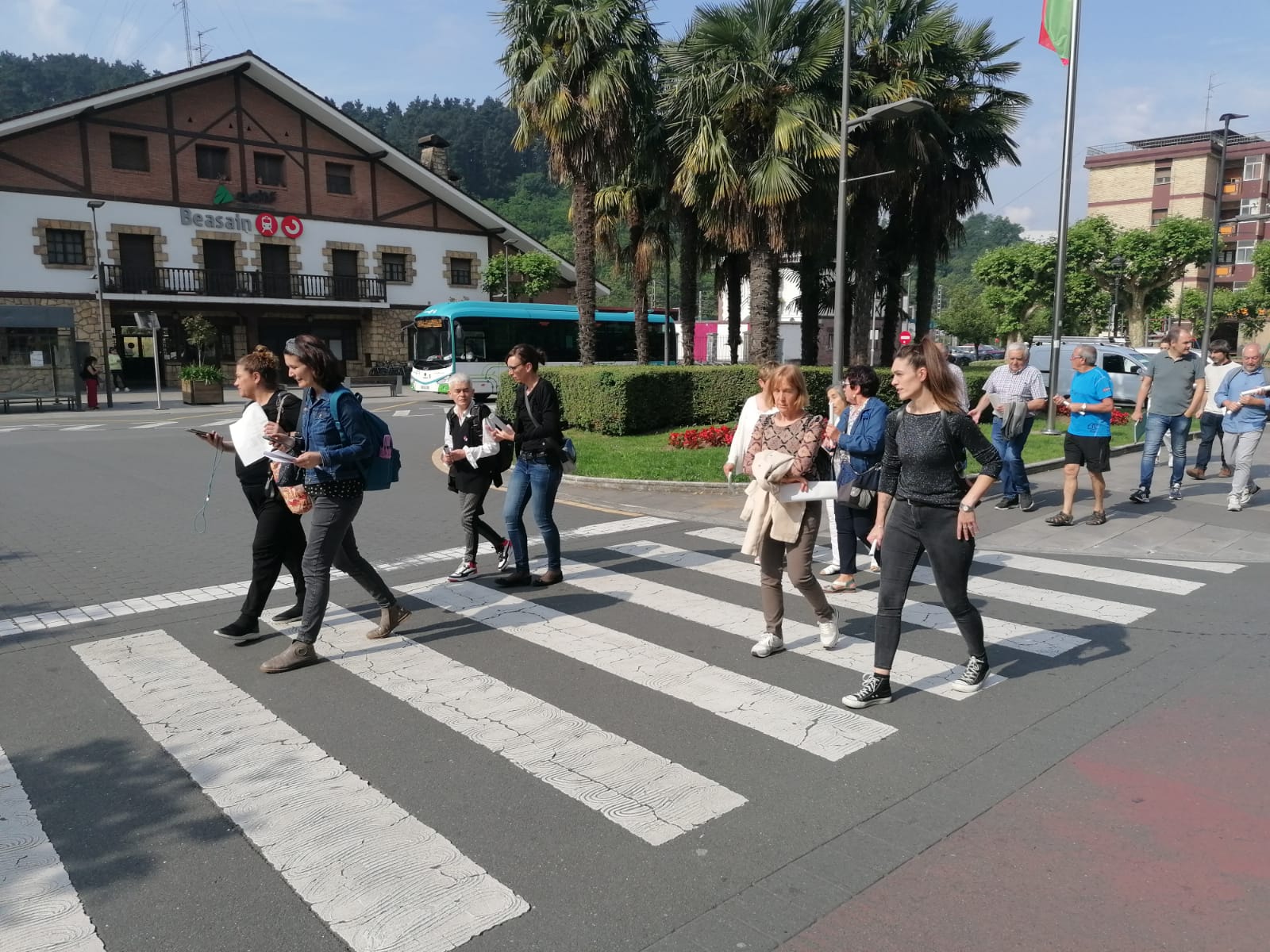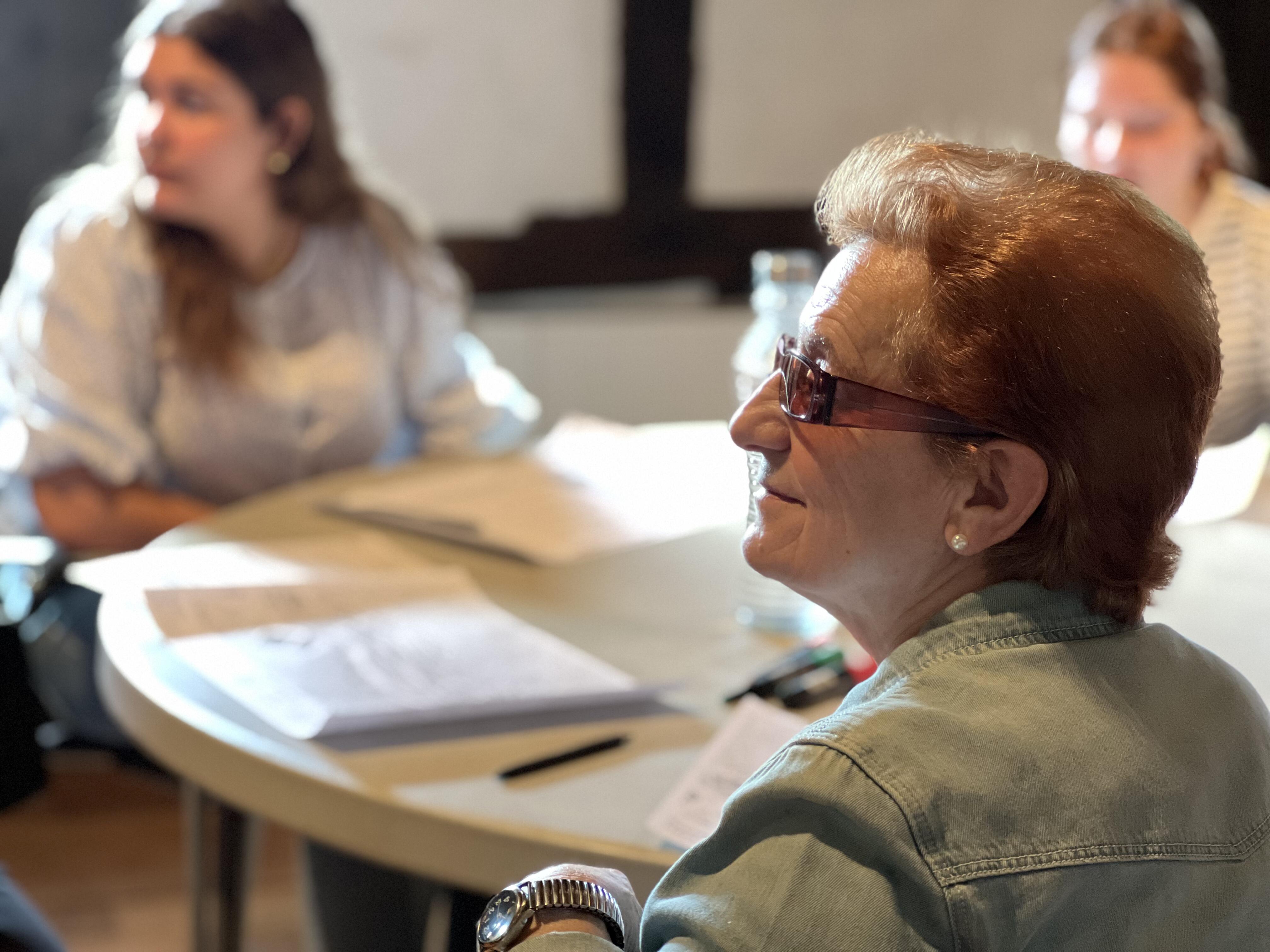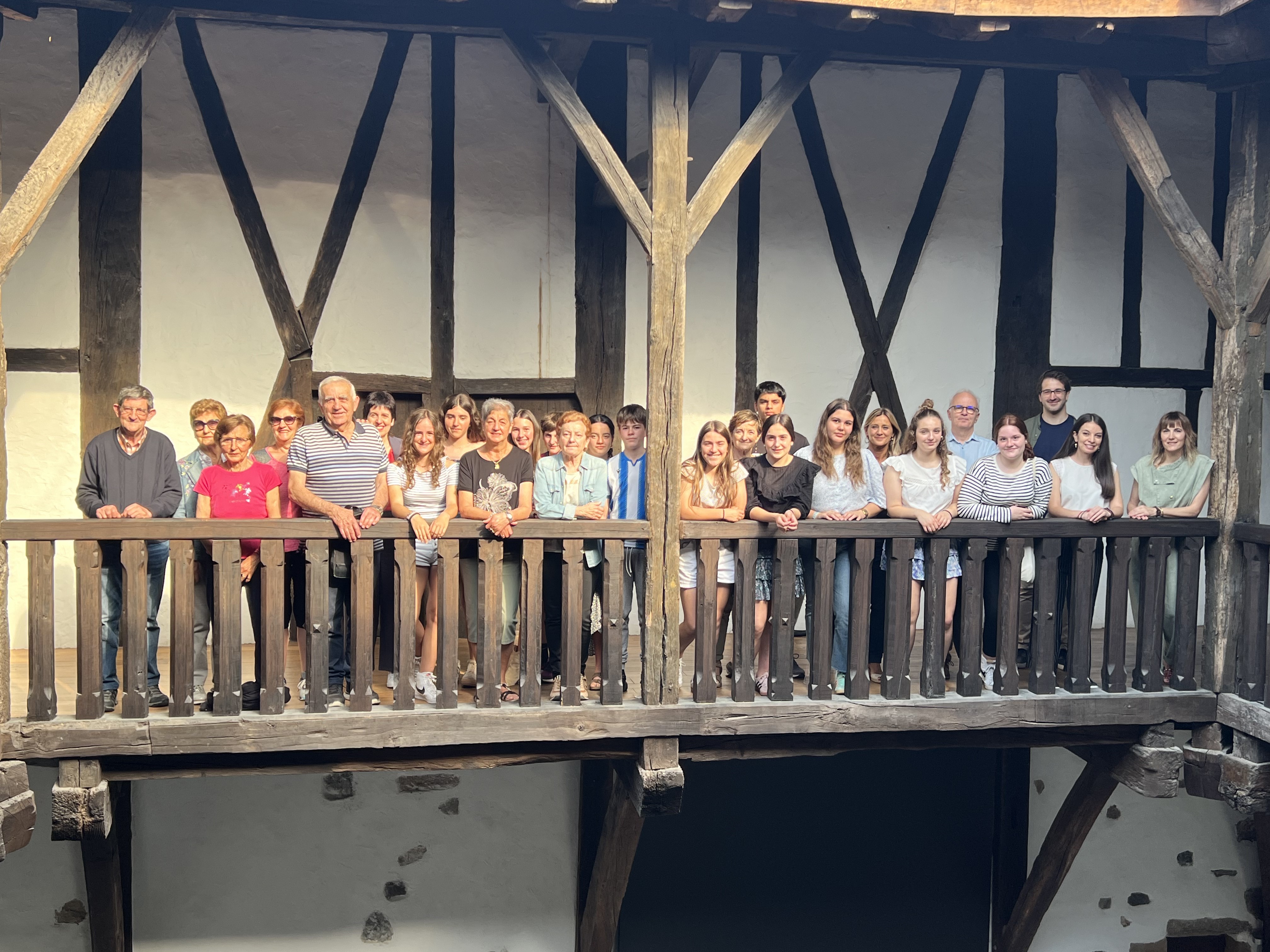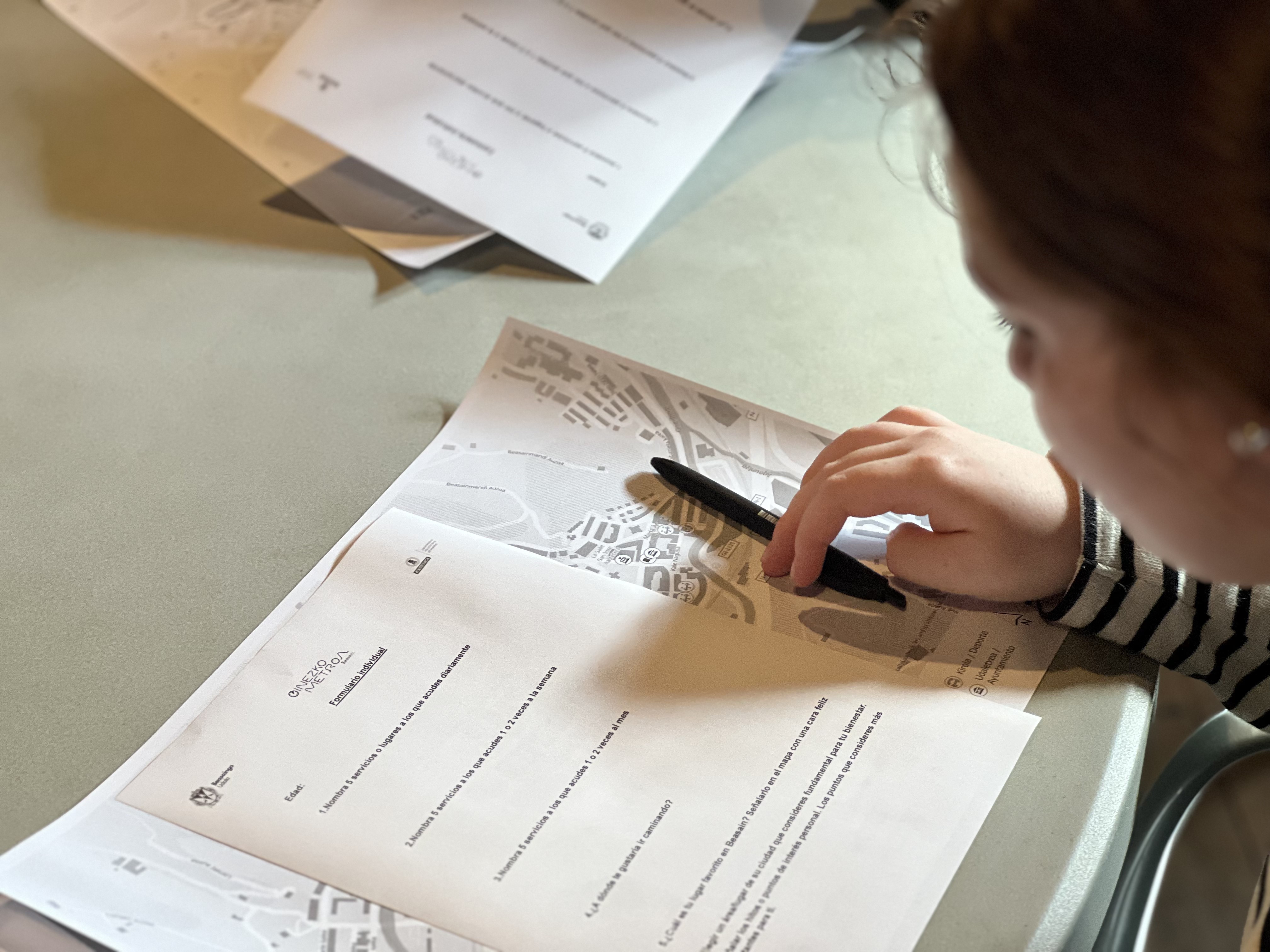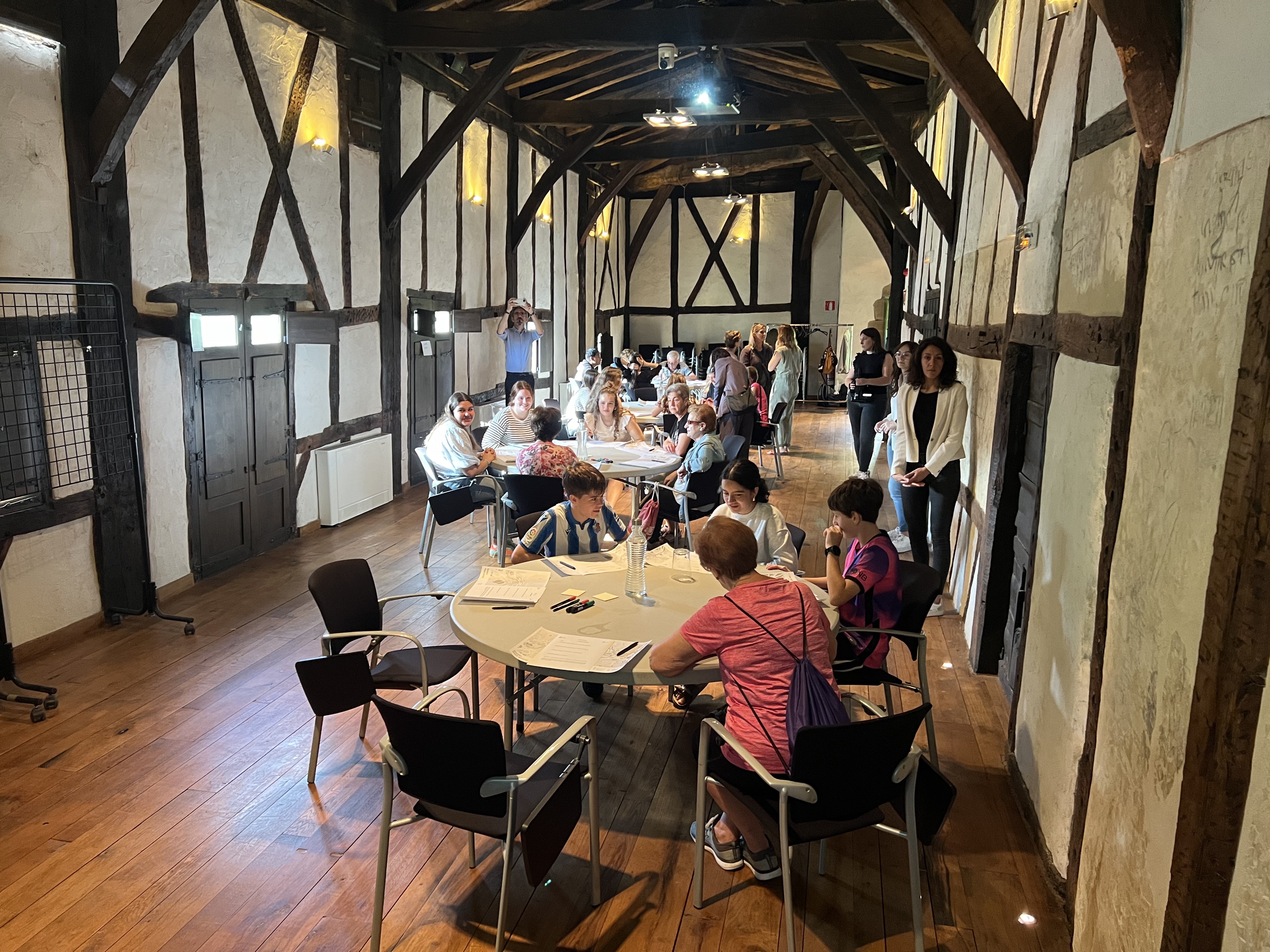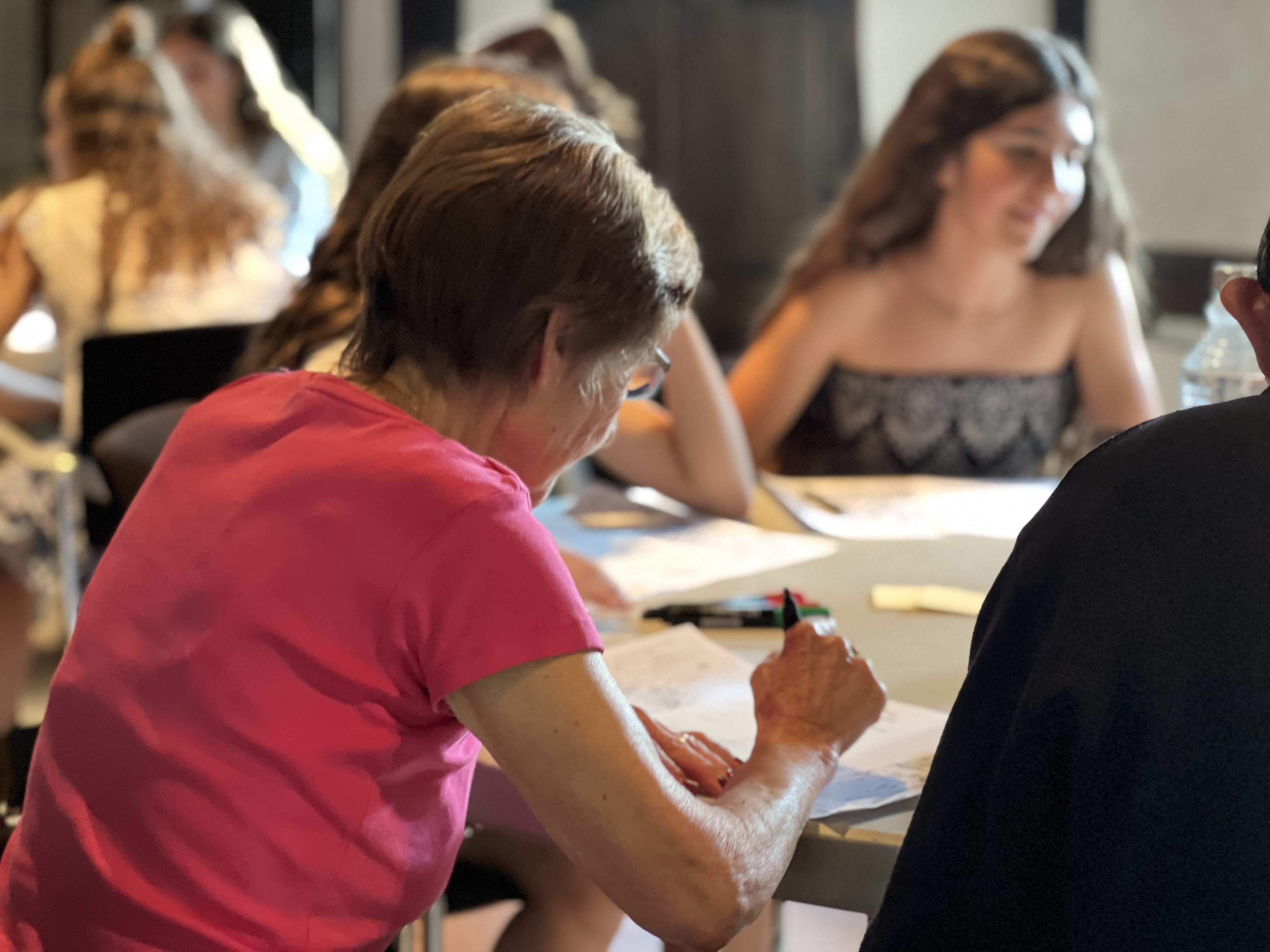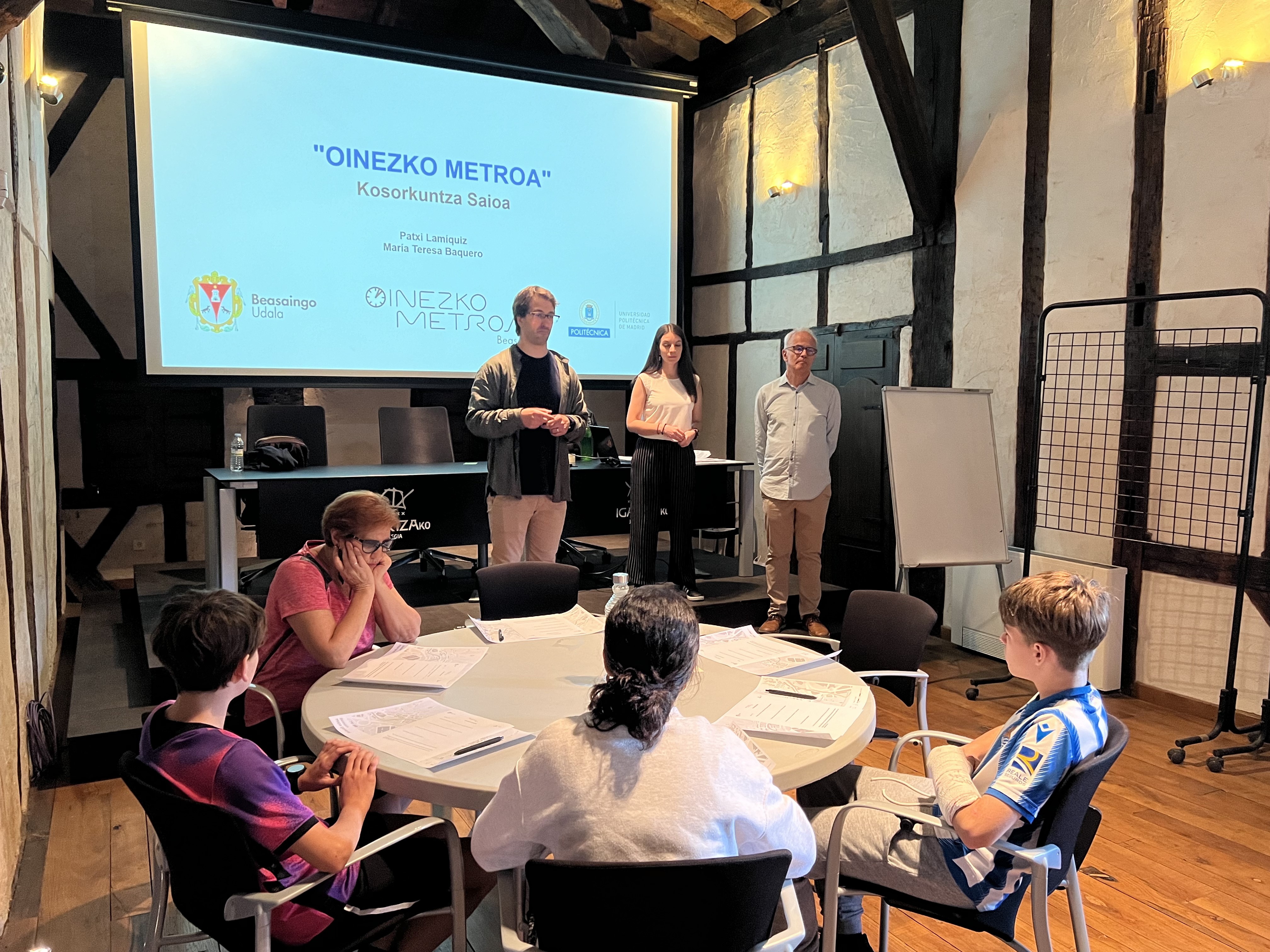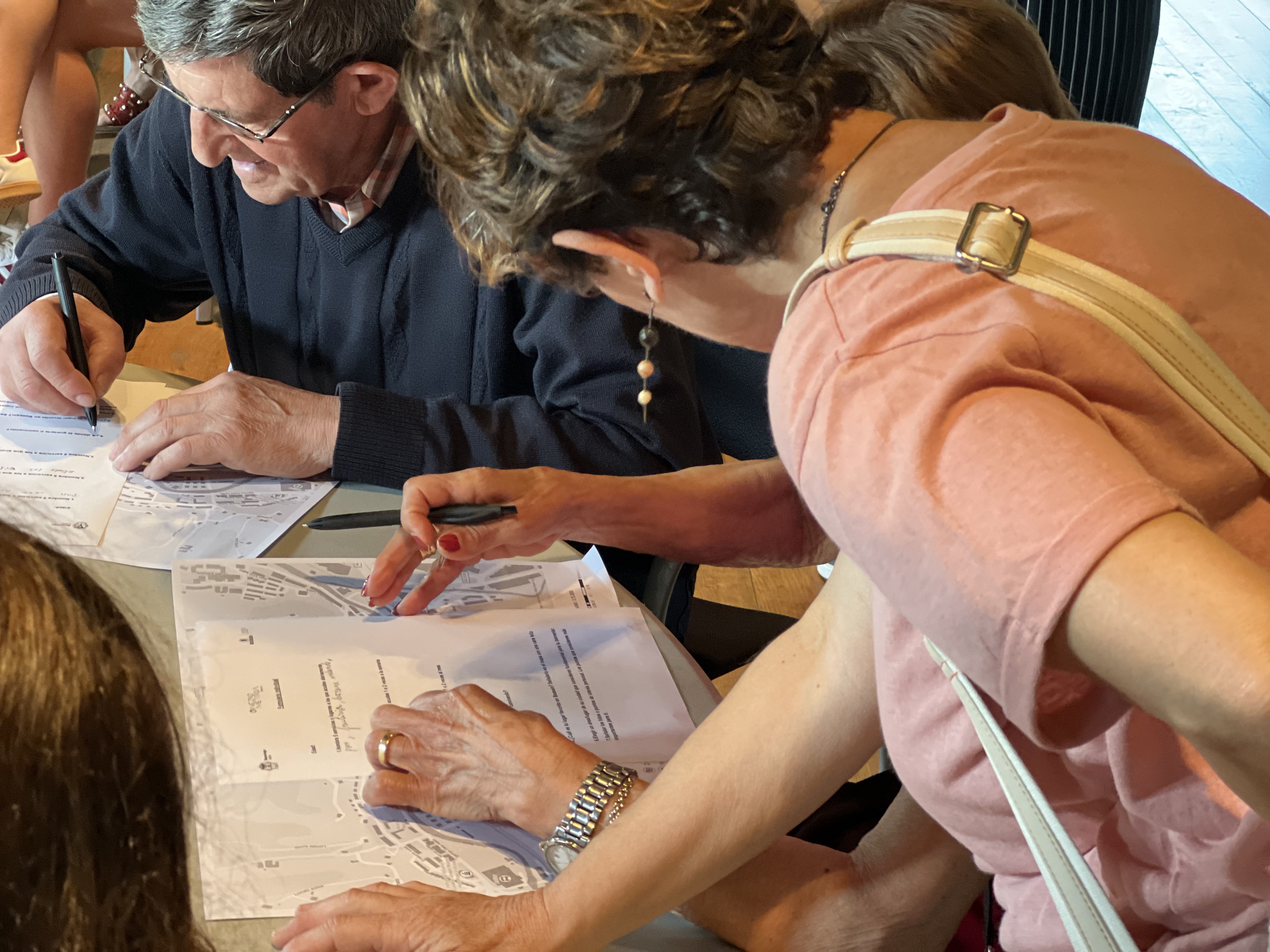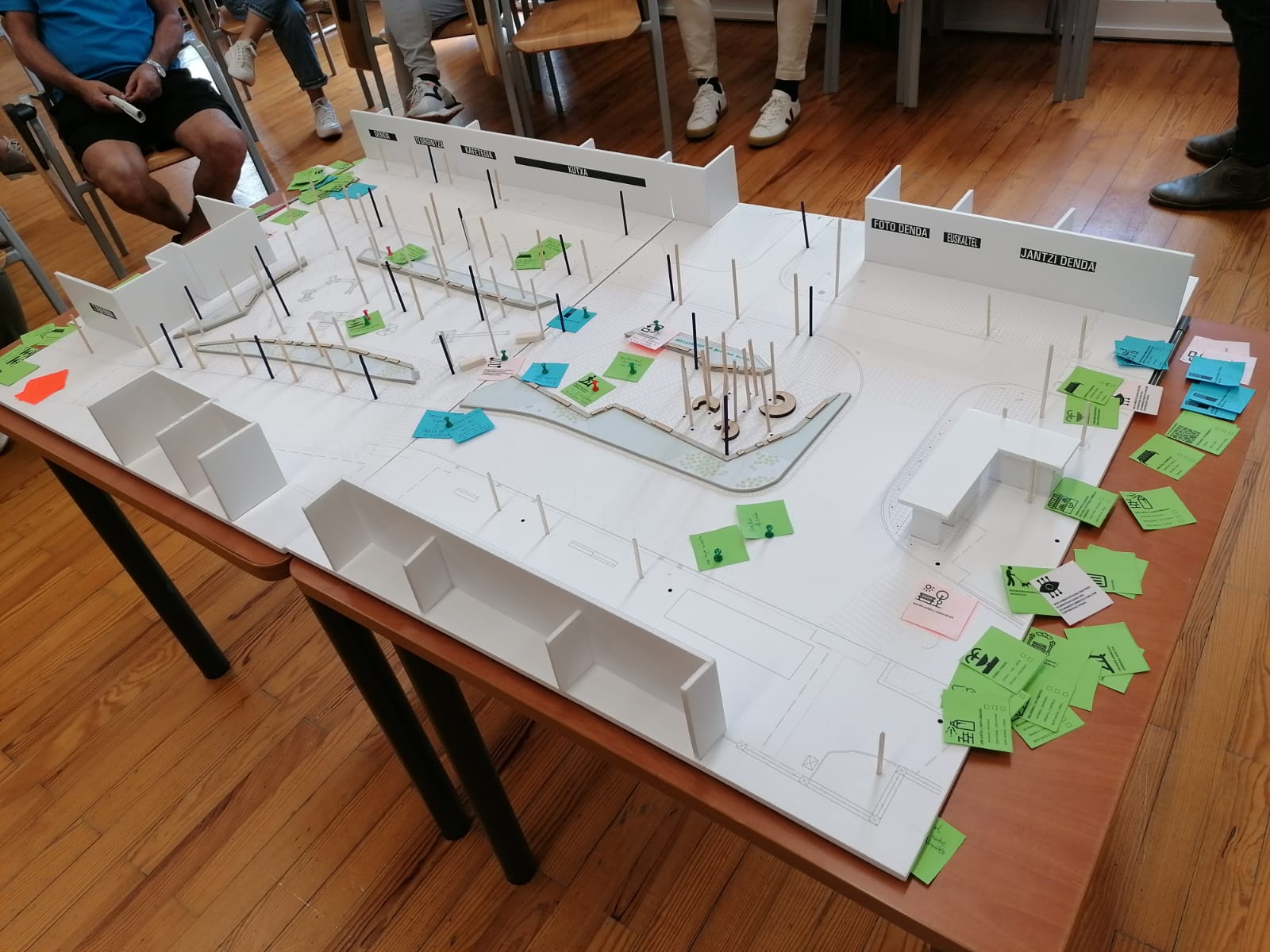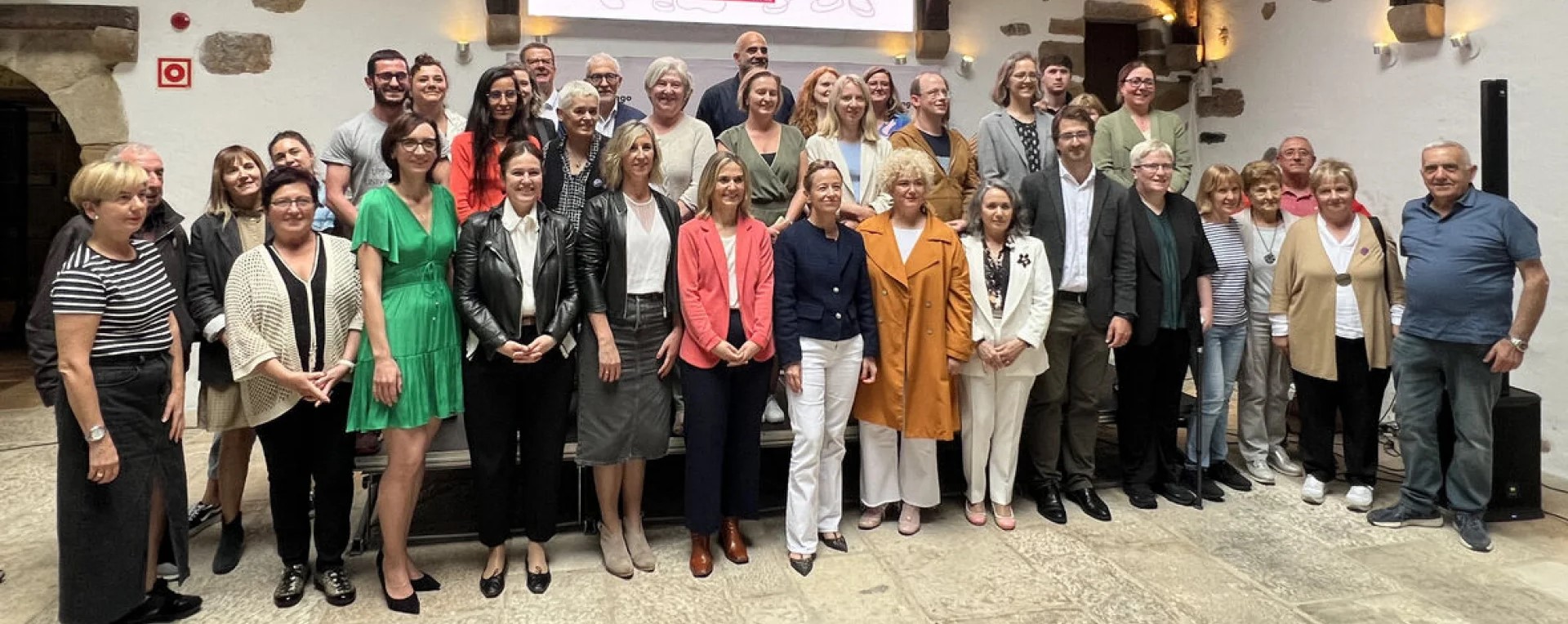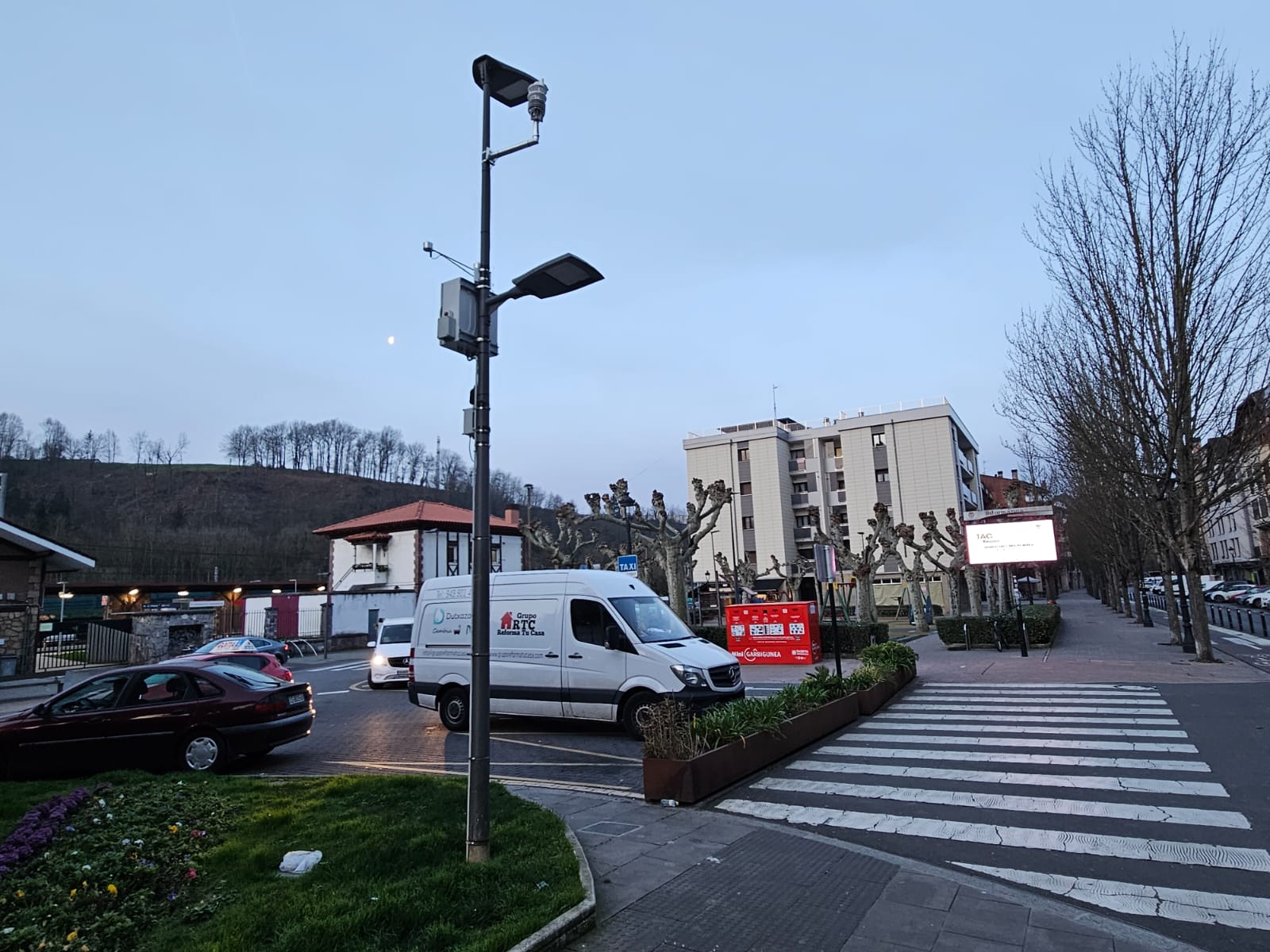Barrendain Plaza
The new Barrendain Plaza, a multi-modal/generational public space
Climate crisis and unwanted loneliness are two of the main challenges of our generaiton.
With a desperating global warming forecast, mobility is one of the keys were Town Halls can act providing multimodal transport infrastructure.
On the other hand, despite being in a digital hyper-connected society, loniless is becoming more and more common for different age groups.
Barrendain is a unique innitaitve where these diverse threats are addressed through urban design based on participation.
With a desperating global warming forecast, mobility is one of the keys were Town Halls can act providing multimodal transport infrastructure.
On the other hand, despite being in a digital hyper-connected society, loniless is becoming more and more common for different age groups.
Barrendain is a unique innitaitve where these diverse threats are addressed through urban design based on participation.
Spain
https://maps.app.goo.gl/WWFLPF8rq1c1JpkZ9
Prototype level
Yes
Yes
Yes
No
No
20019: Beasain (ES)
Design of quality public space that encourage active enjoyment, social and intergenerational relationships, mitigate unwanted loneliness, and reinforce Beasain as a town of relationships. At the same time, Barrendain Plaza seeks to become a multi-modal hub where services such as carpooling, car-sharing and bike-sharing among others would be available to reduce private car dependancy of rural areas like Goierri where lack of public transport and isolation is a reality. The strategy to achive these two goals has been implemented in parallel and integrated in the final design of Barrendain Plaza.
To face the mobility challenge, the Sustainable Urban Mobility Plan of Beasain Town Hall has been the cornerstone from which differents actions have arosen. Digital surveys, face to face surveys and intergenerational workshops among other actions have been implemented in order to define the role that Barrendain has to play as inner and external mobility asset. Roundtables with local industrial companies have also taken place to contrast the needs of their workforce and analyse potential funding and implementation synergies with diverse stakeholders.
On the other hand, Beasain Town Hall has colaborated with architecture studios, institutions, foundations and university research groups to create a participation process where citizens and local associations would actively take part in the co-creative urban design process of Barrendain. This second working line was focused on identifying design features of the first project draft that could be negative from the universal accesibility point of view, together with suggesting improvements to make the plaza a place where intergenerational relations would be boosted.
The outcome is the refurbishment of an existing roundabout into a new pedestrian space where multi-modal services would be offered while new possibilities fort he ineraction of different age groups will take place.
To face the mobility challenge, the Sustainable Urban Mobility Plan of Beasain Town Hall has been the cornerstone from which differents actions have arosen. Digital surveys, face to face surveys and intergenerational workshops among other actions have been implemented in order to define the role that Barrendain has to play as inner and external mobility asset. Roundtables with local industrial companies have also taken place to contrast the needs of their workforce and analyse potential funding and implementation synergies with diverse stakeholders.
On the other hand, Beasain Town Hall has colaborated with architecture studios, institutions, foundations and university research groups to create a participation process where citizens and local associations would actively take part in the co-creative urban design process of Barrendain. This second working line was focused on identifying design features of the first project draft that could be negative from the universal accesibility point of view, together with suggesting improvements to make the plaza a place where intergenerational relations would be boosted.
The outcome is the refurbishment of an existing roundabout into a new pedestrian space where multi-modal services would be offered while new possibilities fort he ineraction of different age groups will take place.
Multi-modal hub
Unwanted loneliness
Active mobility
Inclussiveness
Multigenerational approach
According to the Energy and Climate Action Plan of Beasain, 74% of the Greenhouse Effect Gasses generated by our citizens come from mobility. In other words, mobility is a key subject where the Town Hall has competencies and resources to generate a direct and possitive impact.
One of the reasons of why three quartes of our emissions have to do with mobility is the isolation that the Beasain suffers from the public transport point of view. The town is poorly connected with the main cities and other industrial areas and as a result, private car is almost mandatory for most of our popullation. Workforce coming every day to the big companies placed in Beasain (the leading one with over 3.000 employees) are in the same situation and as a result, thousands of cars come and go every day polluting urban air and generating road safety issues.
Boosting active mobility through initiatives like the "Walkable Subway of Beasain"together with implementing multi-modal transport services such as bike-sharing in Barrendain, which is located right next to the train station, would allow to cover the last-mile connection between the station and the diverse industrial areas around Beasain. This is something that has been confirmed beyond the SUMP by collecting digital and face surveys around the intervention area. At the same time, companies mentioned above have also corroborated that their Corporate Mobility plans agree on the diagnosis regarding the need of last-mile shared mobility solutions.
In order to measure the impact that the refurbishment may have in the air quality, a meteorogical station was implemented in june 2024 in the future Barrendain plaza to record a whole year of metrics in relation with pollutant particles, temperature, hummidity, etc.
Moreover, thanks to weather station and sustainbale urban design, it is expected to have a measurable reduction of the heat island-effect comparing the data between the actual data and the one after the intervention.
One of the reasons of why three quartes of our emissions have to do with mobility is the isolation that the Beasain suffers from the public transport point of view. The town is poorly connected with the main cities and other industrial areas and as a result, private car is almost mandatory for most of our popullation. Workforce coming every day to the big companies placed in Beasain (the leading one with over 3.000 employees) are in the same situation and as a result, thousands of cars come and go every day polluting urban air and generating road safety issues.
Boosting active mobility through initiatives like the "Walkable Subway of Beasain"together with implementing multi-modal transport services such as bike-sharing in Barrendain, which is located right next to the train station, would allow to cover the last-mile connection between the station and the diverse industrial areas around Beasain. This is something that has been confirmed beyond the SUMP by collecting digital and face surveys around the intervention area. At the same time, companies mentioned above have also corroborated that their Corporate Mobility plans agree on the diagnosis regarding the need of last-mile shared mobility solutions.
In order to measure the impact that the refurbishment may have in the air quality, a meteorogical station was implemented in june 2024 in the future Barrendain plaza to record a whole year of metrics in relation with pollutant particles, temperature, hummidity, etc.
Moreover, thanks to weather station and sustainbale urban design, it is expected to have a measurable reduction of the heat island-effect comparing the data between the actual data and the one after the intervention.
The innitiative addresses, from the field of Architecture, one of the EU’s priorities and distinctive areas, as included in the European Construction Technology Platform (ECTP): Quality of Life.
It places particular emphasis on the social responsibility of the actors involved in the creative-constructive process and on the need to foster an interactive dialogue with users. Thus, human perception is brought back to the forefront of development and research activities.
For this reason, the research areas of CAVIAR, the leading academic entity in the architectural field for Barrendain Plaza, are connected through three cross-cutting focus areas related to people, the environment and efficient management:
A1: Quality of Life, Health and well-being, Comfort, Human-built environment interaction, Renaturalization: Nice, accesible and inclusive public space is the one where universal accesibility is guaranteed, from pavement to urban furniture, and naturalization is an ally to reduce the heat-island effect.
A2: Sustainability, Climate neutrality, Energy efficiency, Circular economy, Life cycle, Industrialization: In contrast to traditional children playgrounds, the one located in Barrendain is a natur-based design from tree trunks, avoiding plastic and other materials manufactured with fossil resources.
A3: Regeneration and Urban Transitions: mobility and technologies for increasing capacities, urban renewable electricity: Shared mobility services to facilitate last-mile connections from Barrendain Plaza have the potential to improve competitiveness of public transport. At the same time, Barrendain is the center point of a conceptual walkable net to promote walkable mobility instead of private car use to move along Beasain.
It places particular emphasis on the social responsibility of the actors involved in the creative-constructive process and on the need to foster an interactive dialogue with users. Thus, human perception is brought back to the forefront of development and research activities.
For this reason, the research areas of CAVIAR, the leading academic entity in the architectural field for Barrendain Plaza, are connected through three cross-cutting focus areas related to people, the environment and efficient management:
A1: Quality of Life, Health and well-being, Comfort, Human-built environment interaction, Renaturalization: Nice, accesible and inclusive public space is the one where universal accesibility is guaranteed, from pavement to urban furniture, and naturalization is an ally to reduce the heat-island effect.
A2: Sustainability, Climate neutrality, Energy efficiency, Circular economy, Life cycle, Industrialization: In contrast to traditional children playgrounds, the one located in Barrendain is a natur-based design from tree trunks, avoiding plastic and other materials manufactured with fossil resources.
A3: Regeneration and Urban Transitions: mobility and technologies for increasing capacities, urban renewable electricity: Shared mobility services to facilitate last-mile connections from Barrendain Plaza have the potential to improve competitiveness of public transport. At the same time, Barrendain is the center point of a conceptual walkable net to promote walkable mobility instead of private car use to move along Beasain.
Barrendain Plaza is part of the KALELAGUN innitiative, boosted by the Provincial Council of Gipuzkoa and ADINBERRI Foundation in collaboration with Beasain Town Hall as a living lab to adopt an architectural/urban planning and interdisciplinary approach, based on the design of high-quality outdoor meeting spaces (squares, streets, parks, etc.) that encourage active enjoyment of the immediate environment.
This includes strengthening social relationships, promoting physical activity and integrating digital technologies for support these goals.
In addition, it is proposed to study in detail the characteristic social, architectural and urban aspects of the urban meeting environments of the territory of Gipuzkoa, including Barrendain plaza in Beasain to:
• Promote active, inclusive and diverse aging through accessible and friendly public outdoor spaces that foster social interaction and encourage physical activity for all.
• Prevent and mitigate perceptions of unwanted loneliness through the design of outdoor spaces, which improve emotional health and promote the social inclusion of the elderly.
• Increase functional autonomy and improve the perception of safety (especially among women), to enabling all older individuals to navigate and enjoy the urban and/or rural environment with ease and quality.
• Support independent living and bridge the digital divide by designing smart digital urban environments.
• Create a design guide for professionals and institutions involved in urban planning to foster the transformation of the physical space that people walk through.
• Develop several pilot projects, applying the design guide developed to evaluate, improve and validate the proposed model.
• Define a roadmap to support the institutions involved or interested in the actual execution of the pilot projects.
• Promote the model proposed in Gipuzkoa in the rest of the Basque Country, Spain and Europe.
This includes strengthening social relationships, promoting physical activity and integrating digital technologies for support these goals.
In addition, it is proposed to study in detail the characteristic social, architectural and urban aspects of the urban meeting environments of the territory of Gipuzkoa, including Barrendain plaza in Beasain to:
• Promote active, inclusive and diverse aging through accessible and friendly public outdoor spaces that foster social interaction and encourage physical activity for all.
• Prevent and mitigate perceptions of unwanted loneliness through the design of outdoor spaces, which improve emotional health and promote the social inclusion of the elderly.
• Increase functional autonomy and improve the perception of safety (especially among women), to enabling all older individuals to navigate and enjoy the urban and/or rural environment with ease and quality.
• Support independent living and bridge the digital divide by designing smart digital urban environments.
• Create a design guide for professionals and institutions involved in urban planning to foster the transformation of the physical space that people walk through.
• Develop several pilot projects, applying the design guide developed to evaluate, improve and validate the proposed model.
• Define a roadmap to support the institutions involved or interested in the actual execution of the pilot projects.
• Promote the model proposed in Gipuzkoa in the rest of the Basque Country, Spain and Europe.
Active involvement from community members is crucial to ensuring that public spaces meet their needs and foster a sense of ownership. Barrendain Plaza project has created forums and opportunities for local residents, associations, companies, and authorities to collaboratively design a new local environment and create potential mobility networks & services.
This objective hass been achieved through structured activities and extending these practices into governance and legacy aspects, ensuring long-term and widespread impact.
Barrendain was dedicated to fostering inclusivity and equity by actively engaging a broad spectrum of community members, particularly those who are often underrepresented or marginalized. This objective focused on breaking down barriers that typically exclude diverse groups—such as children or senior collectives from participating in public space design. This approach has ensured that everyone, regardless of their age group has the opportunity to contribute their perspectives and needs in shaping their local environments.
To achieve this, tailored outreach strategies were implemented to effectively engage these groups. This included partnering with local institutes, collaborating with community organizations serving women collectives, and conducting specialized sessions.
This objective hass been achieved through structured activities and extending these practices into governance and legacy aspects, ensuring long-term and widespread impact.
Barrendain was dedicated to fostering inclusivity and equity by actively engaging a broad spectrum of community members, particularly those who are often underrepresented or marginalized. This objective focused on breaking down barriers that typically exclude diverse groups—such as children or senior collectives from participating in public space design. This approach has ensured that everyone, regardless of their age group has the opportunity to contribute their perspectives and needs in shaping their local environments.
To achieve this, tailored outreach strategies were implemented to effectively engage these groups. This included partnering with local institutes, collaborating with community organizations serving women collectives, and conducting specialized sessions.
Local stakeholders
• Beasain Town Hall
• Urbiberri - Senior citizens association of Beasain
• Asmube - Women association of Beasain
• Beasain Institute - Secondary education
• Ondo Ibili, Ondo Izan - Senior citizens for active mobility
Beasain Town Hall has been the local partner an facilitator to get together local associations and institutions generating a multigenerational local representative group. Asmube and Urbiberri where more focused on the urban design and characteristics of Barredain plaza, while Ondo Ibili, Ondo Izan and Beasain Institute students worked on the walkability of Beasain and the role that pedestrian networks and Barrendain could play for the active mobility of Beasain.
Regional Stakeholders
• CAVIAR Research Group - Architecture
• ENEDI Research Group - Engineering
• Intelligent System Group - Computing
• CRIM-AP Research Group - Applied Criminology
• Provincial Council of Gipuzkoa
• ADINBERRI Foundation
• Fiark Arquitectos
CAVIAR led the mutidisciplinary research consortium from the architectural point of view for the refurbishment of Barrendain Plaza, while the Provincial Council of Gipuzkoa and ADINBERRI Foundation were the promoters of KALELAGUN innitiative.
National Stakeholders
• Universidad Politécnica de Madrid
Architect Patxi Lamiquiz from UPM has been the leader of the working group that collaborated with Ondo Ibili, Ondo Izan and Beasain Institute to generate OINEZKO METROA, an innitiative that generates a conceptual "Walking Subway" (also known as Metrominuto in Spanish) to promote active mobility. Barrendain plaza played a relevant role as a central space in Beasain, including the train station.
European Stakeholders
• Bable Smart Cities
This consulting company based in Sttutgart lead the strategy to promote multi-modal transport services around Barrendain. They were in charge to design the surveys for the citizens and roundtables with local companies to generate potential collaborations.
• Beasain Town Hall
• Urbiberri - Senior citizens association of Beasain
• Asmube - Women association of Beasain
• Beasain Institute - Secondary education
• Ondo Ibili, Ondo Izan - Senior citizens for active mobility
Beasain Town Hall has been the local partner an facilitator to get together local associations and institutions generating a multigenerational local representative group. Asmube and Urbiberri where more focused on the urban design and characteristics of Barredain plaza, while Ondo Ibili, Ondo Izan and Beasain Institute students worked on the walkability of Beasain and the role that pedestrian networks and Barrendain could play for the active mobility of Beasain.
Regional Stakeholders
• CAVIAR Research Group - Architecture
• ENEDI Research Group - Engineering
• Intelligent System Group - Computing
• CRIM-AP Research Group - Applied Criminology
• Provincial Council of Gipuzkoa
• ADINBERRI Foundation
• Fiark Arquitectos
CAVIAR led the mutidisciplinary research consortium from the architectural point of view for the refurbishment of Barrendain Plaza, while the Provincial Council of Gipuzkoa and ADINBERRI Foundation were the promoters of KALELAGUN innitiative.
National Stakeholders
• Universidad Politécnica de Madrid
Architect Patxi Lamiquiz from UPM has been the leader of the working group that collaborated with Ondo Ibili, Ondo Izan and Beasain Institute to generate OINEZKO METROA, an innitiative that generates a conceptual "Walking Subway" (also known as Metrominuto in Spanish) to promote active mobility. Barrendain plaza played a relevant role as a central space in Beasain, including the train station.
European Stakeholders
• Bable Smart Cities
This consulting company based in Sttutgart lead the strategy to promote multi-modal transport services around Barrendain. They were in charge to design the surveys for the citizens and roundtables with local companies to generate potential collaborations.
Architecture
• CAVIAR Research Group - UPV/EHU
• Universidad Politécnica de Madrid - UPM
• Fiark Arquitectos
Engineering & Computing
• ENEDI Research Group - UPV/EHU
• Intelligent System Group - UPV/EHU
Psychology
• CRIM-AP Research Group (Applied Criminology) - UPV/EHU
Smart Cities & Mobility
• BABLE Smart Cities
These diverse entities have collaborated thorugh the multidisciplinary groups below:
G1 - Urban Design, Unwanted Loneliness and Multigenerational Approach (CAVIAR, ENDI, ISG, CRIM-AP, Fiark Arquitectos)
This multidisciplinary group was lead by CAVIAR to first analyse the draft project that was originaly developed by FIARK Arquitectos as per Beasain Town Hall award. CAVIAR went through the participation process with the local associations and citizens and suggested some adjustments for the final design. These suggestions were first shared in an interaction with CRIM-AP to include safety perception and multigenerational perception measures. ENDI and ISP offered support with the sensoring infrastrucuture of the wather station.
G2 - Active Mobility (UPM)
Patxi Lamiquiz and his team lead the OINEZKO METROA or "Walkable Subway" innitiative thorugh a workshop with Beasain Institute and Ondo Ibili, Ondo Izan members. The result is a plan that simulates a conceptual subway map of Beasain where Barrendain plays a central role
G3 - Shared Multi-Modal Mobility (Bable Smart Cities)
Bable designed and lead the strategy for a diagnosis and implementation of multimodal services in Beasain to make Barrendain a multi-modal hub. Citizens took part trough interviews, surveys and local companies thorugh roundtables.
• CAVIAR Research Group - UPV/EHU
• Universidad Politécnica de Madrid - UPM
• Fiark Arquitectos
Engineering & Computing
• ENEDI Research Group - UPV/EHU
• Intelligent System Group - UPV/EHU
Psychology
• CRIM-AP Research Group (Applied Criminology) - UPV/EHU
Smart Cities & Mobility
• BABLE Smart Cities
These diverse entities have collaborated thorugh the multidisciplinary groups below:
G1 - Urban Design, Unwanted Loneliness and Multigenerational Approach (CAVIAR, ENDI, ISG, CRIM-AP, Fiark Arquitectos)
This multidisciplinary group was lead by CAVIAR to first analyse the draft project that was originaly developed by FIARK Arquitectos as per Beasain Town Hall award. CAVIAR went through the participation process with the local associations and citizens and suggested some adjustments for the final design. These suggestions were first shared in an interaction with CRIM-AP to include safety perception and multigenerational perception measures. ENDI and ISP offered support with the sensoring infrastrucuture of the wather station.
G2 - Active Mobility (UPM)
Patxi Lamiquiz and his team lead the OINEZKO METROA or "Walkable Subway" innitiative thorugh a workshop with Beasain Institute and Ondo Ibili, Ondo Izan members. The result is a plan that simulates a conceptual subway map of Beasain where Barrendain plays a central role
G3 - Shared Multi-Modal Mobility (Bable Smart Cities)
Bable designed and lead the strategy for a diagnosis and implementation of multimodal services in Beasain to make Barrendain a multi-modal hub. Citizens took part trough interviews, surveys and local companies thorugh roundtables.
1- Measurability based on data - Weather Station:
Beyond subjective perceptions, measurable data provides an objetive view in order to valorate the possitive or negative impacts on the intervention of public space. Thanks to the weather station already installed at Barrendain, a whole year of data will be recorded to compare the comfort and atmospheric parameters before and after the intervention.
2- Combination of diverse topics and methodologies - Social & Mobility perspective
As an urban open public space, it was clear from the very beggining that Barrendain had to become an asset to foster social realtionships, specially the intergenerational ones takin into account that unwanted loneliness is a phenomenon affecti all groups of ages. But at the same time, as a train station plaza, Barrendain was also an opportunity to decrease the car dependancy of rural areas like Beasain and Goierri region, offering multim-modal on demand services to cover last-mile connections between the trains station and other spots throughout Beasain. Both needs and visions have been integrated in a single urban solution.
3- Participation of private stakeholders - Local industry: Despite like in big cities and metropolies, it is complicated to find feasable finance-models to allow the implementation of multi-nodal services such as bike-sharing in rural areas due to the lack of volume of its market (popullation). Involving local companies with hundreds or thousands of employees, opens a new opportunity, as longs as urban mobility needs and Company Mobility Plan needs are both taken into consideration. As a result, Beasain City Hall is making some steps in order to launch bike-sharing service, while carpooling and car-sharing are already being offered to our citizens.
Beyond subjective perceptions, measurable data provides an objetive view in order to valorate the possitive or negative impacts on the intervention of public space. Thanks to the weather station already installed at Barrendain, a whole year of data will be recorded to compare the comfort and atmospheric parameters before and after the intervention.
2- Combination of diverse topics and methodologies - Social & Mobility perspective
As an urban open public space, it was clear from the very beggining that Barrendain had to become an asset to foster social realtionships, specially the intergenerational ones takin into account that unwanted loneliness is a phenomenon affecti all groups of ages. But at the same time, as a train station plaza, Barrendain was also an opportunity to decrease the car dependancy of rural areas like Beasain and Goierri region, offering multim-modal on demand services to cover last-mile connections between the trains station and other spots throughout Beasain. Both needs and visions have been integrated in a single urban solution.
3- Participation of private stakeholders - Local industry: Despite like in big cities and metropolies, it is complicated to find feasable finance-models to allow the implementation of multi-nodal services such as bike-sharing in rural areas due to the lack of volume of its market (popullation). Involving local companies with hundreds or thousands of employees, opens a new opportunity, as longs as urban mobility needs and Company Mobility Plan needs are both taken into consideration. As a result, Beasain City Hall is making some steps in order to launch bike-sharing service, while carpooling and car-sharing are already being offered to our citizens.
G1 - Urban Design, Unwanted Loneliness and Multigenerational Approach (CAVIAR, ENDI, ISG, CRIM-AP, Fiark Arquitectos)
-Multidisciplinar working research group: While acting as the leader of this group from the architectural point of view, CAVIAR managed to include research patterns from fields like psychology by the time of suggesting upgrades on the initial project developed by Fiark. At the same time, engineering and computing were involved for data measurement.
-Non-invasive observation: CAVIAR carried out a non-invasive observation of citizens at the existing Barrendain plaza to see how behavioral patterns may change after the refurbishment.
-Co-creation workshop: Local associations were involved in co-creation workshops, including an on-site visite and intervening on a physical architectural model of Barrendain Plaza.
G2 - Active Mobility (UPM)
-Analysis based on existing data: The first step was to collect all available data including cartography, SUMP, Urban Plan and others to submit a preliminary design.
-On-site visit: This visit was useful to integrate the on-site perspective and generate the second version by UPM research group.
-Multigenerational co-creation workshop: students from secondary togeher with members from elderly associations, worked on the second draft to include their main hotspots and routes in the map, as well as reflecting about the role that Barrendain should play in the walkable net of Oinezko Metroa.
G3 - Shared Multi-Modal Mobility (Bable SC)
-Face to face surveys: Right at Barrendain's train station to understand the mobility patterns and needs of current users.
-Digital surveys:Thanks to digital platforms like social media, the same survey was available for all citizens.
-Roundatables with local industries: The goal was to indentify potential synergies to implement multi-modal mobility services in Barrendain and other location to cober the last-mile connectivity from Barrendain to their HQ.
-Multidisciplinar working research group: While acting as the leader of this group from the architectural point of view, CAVIAR managed to include research patterns from fields like psychology by the time of suggesting upgrades on the initial project developed by Fiark. At the same time, engineering and computing were involved for data measurement.
-Non-invasive observation: CAVIAR carried out a non-invasive observation of citizens at the existing Barrendain plaza to see how behavioral patterns may change after the refurbishment.
-Co-creation workshop: Local associations were involved in co-creation workshops, including an on-site visite and intervening on a physical architectural model of Barrendain Plaza.
G2 - Active Mobility (UPM)
-Analysis based on existing data: The first step was to collect all available data including cartography, SUMP, Urban Plan and others to submit a preliminary design.
-On-site visit: This visit was useful to integrate the on-site perspective and generate the second version by UPM research group.
-Multigenerational co-creation workshop: students from secondary togeher with members from elderly associations, worked on the second draft to include their main hotspots and routes in the map, as well as reflecting about the role that Barrendain should play in the walkable net of Oinezko Metroa.
G3 - Shared Multi-Modal Mobility (Bable SC)
-Face to face surveys: Right at Barrendain's train station to understand the mobility patterns and needs of current users.
-Digital surveys:Thanks to digital platforms like social media, the same survey was available for all citizens.
-Roundatables with local industries: The goal was to indentify potential synergies to implement multi-modal mobility services in Barrendain and other location to cober the last-mile connectivity from Barrendain to their HQ.
Beasain and Barrendain Plaza have been the first example, but the methodology carried out by CAVIAR in Group1, is being already implemented in other two municipalities of the Basque Country like Arrasate and Donostia - San Sebastian.
The comparisson of user behavioural data and air quality & weather data after and before the intervention, will allow to validate the architectural design features that had a positive impact in the social interaction and the heat-island effect. This validated measures would allow CAVIAR to develope a public space Design Guide that could be transferred to other places and groups.
The aggregated value that Beasain case may represent compared to Arrasate and Donostia, is the integration of another challenge/view like mobility and the integration of two extra working groups and their works in the final design for Barrendain.
Depending on the features of other intervention areas, beyond G1 topic (Urban Design, Unwanted Loneliness and Multigenerational Approach), third parallel studies could be developed and included in the process. Being placed in front of the train station, mobility was almost an evident field to work on for Beasain, but many others could also be benefficial for the final design depending on the local specific needs.
The comparisson of user behavioural data and air quality & weather data after and before the intervention, will allow to validate the architectural design features that had a positive impact in the social interaction and the heat-island effect. This validated measures would allow CAVIAR to develope a public space Design Guide that could be transferred to other places and groups.
The aggregated value that Beasain case may represent compared to Arrasate and Donostia, is the integration of another challenge/view like mobility and the integration of two extra working groups and their works in the final design for Barrendain.
Depending on the features of other intervention areas, beyond G1 topic (Urban Design, Unwanted Loneliness and Multigenerational Approach), third parallel studies could be developed and included in the process. Being placed in front of the train station, mobility was almost an evident field to work on for Beasain, but many others could also be benefficial for the final design depending on the local specific needs.
GC1 - Climate-crisis: For municipalities like Beasain, mobility is the main field where effective actions can be made to mitigate global warming. In fact, three-quartes of our emissions come from excesive private car use and dependancy. Multi-modal mobility services integrated in Barrendain could help to improve the efficiency of public transport (train) through last-mile sharing services like bike-sharing.
GC2 - Mobility in rural regions: In line with GC1, offering carpooling and carsharing services help us reducing the carbon footprint of our citizens by sharing cars in order to reach destinations that public transport does not offer or is not competitive time-wise.
GC 3 - Unwanted Loneliness:Why in a hyperconnected world is the feeling of loneliness more present than ever, especially among young people? According to the latest barometer of unwanted loneliness in the Basque Country (2024), 23.8% of young people between 18 and 34 years old feel lonely. But there are more worrying data: more than 50,000 Basque minors suffer from some type of mental or behavioral disorder. Facilitating intergenerationl social relationship can be key to change the tendency.
GC 4 - Heat-island effect in cities: For decades, concrete and excessive paving of public urban space has lead to denaturation of our surrounding environment. Beyond aesthetics principles, it has also generated comfort and even public health issues due to the heat-island effect in heat waves.
GC 5 - Obesity: Obesity is a complex multifactorial disease defined by excessive adiposity and is linked to
an increased risk for many noncommunicable diseases (NCDs). Overweight and obesity affect almost 60% of adults and nearly one in three children (29% of boys and 27% of girls) in the WHO European Region. Designing walkable cities and urban spaces where social-interactions can easily take place, beyond fighting unwanted loneliness, healthier mobility and social behaviours are boosted.
GC2 - Mobility in rural regions: In line with GC1, offering carpooling and carsharing services help us reducing the carbon footprint of our citizens by sharing cars in order to reach destinations that public transport does not offer or is not competitive time-wise.
GC 3 - Unwanted Loneliness:Why in a hyperconnected world is the feeling of loneliness more present than ever, especially among young people? According to the latest barometer of unwanted loneliness in the Basque Country (2024), 23.8% of young people between 18 and 34 years old feel lonely. But there are more worrying data: more than 50,000 Basque minors suffer from some type of mental or behavioral disorder. Facilitating intergenerationl social relationship can be key to change the tendency.
GC 4 - Heat-island effect in cities: For decades, concrete and excessive paving of public urban space has lead to denaturation of our surrounding environment. Beyond aesthetics principles, it has also generated comfort and even public health issues due to the heat-island effect in heat waves.
GC 5 - Obesity: Obesity is a complex multifactorial disease defined by excessive adiposity and is linked to
an increased risk for many noncommunicable diseases (NCDs). Overweight and obesity affect almost 60% of adults and nearly one in three children (29% of boys and 27% of girls) in the WHO European Region. Designing walkable cities and urban spaces where social-interactions can easily take place, beyond fighting unwanted loneliness, healthier mobility and social behaviours are boosted.
Stage 1- First Project Draft (completed):
Fiark Arquitectos developed a preliminary project draft for Barrendain Plaza
Stage 2 - Urban Design, Unwanted Loneliness and Multigenerational Approach Approach (completed):
G1 lead by CAVIAR carried out the co-creation process with members from local associations to suggest improvements to the preliminary design. At the same time, imputs from the psychology field were taken into consideration thanks to CRIM-AP and non invasive observation sessions were carried out to analyse pedestrian behaviour prior to the intervention.
Stage 3 - Final Project (completed)
Fiark Arquitectos made the necessary changes in the original project according to suggestions from working groups 1,2 and 3.
Stage 4 - Active Mobility Approach (completed):
G2 lead by UPM, developed a "Walking Subway" map with a special attention to Barrendain Plaza and the role it has to play in the walkable net of Beasain.
Stage 5 - Multi-modal Mobility Approach
G3 lead by Bable Smart Cities developed a participation process to identify the needs of pubic/shared transport users and potential new users.
Stage 6 - Monitoring - Weather Station (in progress)
ENDI, ISG researcg groups from G1 together with CAVIAR installed a weather station to record weather and air quality data troughout a whole year. Data before and after the refurbishment will be compared.
Stage 7 - Cosntruction Tender (Q3 2025)
Beasain Town Hall will launch the tender process to award construction works.
Stage 8 - Construction Works (Q4 2025 & Q1 2026)
Estimated construction time is 5-6 months.
Stage 9 - Monitoring - Weather Station (Q2 2025 - Q2 2026): Once the refurbishment has taken place, the weather station will be reinstalled to record data during a year.
Stage 10 - Data Comparisson & Design Guide:
Weather, air quality data and pedestrian behaviour data will be compared after and before the intervention by CAVIAR and transformed into a public space Design Guide.
Fiark Arquitectos developed a preliminary project draft for Barrendain Plaza
Stage 2 - Urban Design, Unwanted Loneliness and Multigenerational Approach Approach (completed):
G1 lead by CAVIAR carried out the co-creation process with members from local associations to suggest improvements to the preliminary design. At the same time, imputs from the psychology field were taken into consideration thanks to CRIM-AP and non invasive observation sessions were carried out to analyse pedestrian behaviour prior to the intervention.
Stage 3 - Final Project (completed)
Fiark Arquitectos made the necessary changes in the original project according to suggestions from working groups 1,2 and 3.
Stage 4 - Active Mobility Approach (completed):
G2 lead by UPM, developed a "Walking Subway" map with a special attention to Barrendain Plaza and the role it has to play in the walkable net of Beasain.
Stage 5 - Multi-modal Mobility Approach
G3 lead by Bable Smart Cities developed a participation process to identify the needs of pubic/shared transport users and potential new users.
Stage 6 - Monitoring - Weather Station (in progress)
ENDI, ISG researcg groups from G1 together with CAVIAR installed a weather station to record weather and air quality data troughout a whole year. Data before and after the refurbishment will be compared.
Stage 7 - Cosntruction Tender (Q3 2025)
Beasain Town Hall will launch the tender process to award construction works.
Stage 8 - Construction Works (Q4 2025 & Q1 2026)
Estimated construction time is 5-6 months.
Stage 9 - Monitoring - Weather Station (Q2 2025 - Q2 2026): Once the refurbishment has taken place, the weather station will be reinstalled to record data during a year.
Stage 10 - Data Comparisson & Design Guide:
Weather, air quality data and pedestrian behaviour data will be compared after and before the intervention by CAVIAR and transformed into a public space Design Guide.

